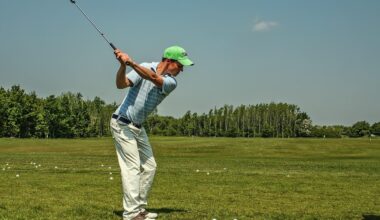Altitude Training Masks: Do They Really Work for Endurance?
Altitude training is often touted for its benefits in improving endurance sports performance. Athletes and trainers believe that simulating high-altitude conditions using masks can enhance oxygen capacity and overall stamina. These masks are designed to restrict airflow, simulating the thin air experienced at high altitudes. This method aims to promote physiological adaptations that can improve endurance. However, the efficacy of using altitude training masks has sparked significant debate among sports scientists. Traditional high-altitude training involves training at elevations above 7,000 feet, leading to increased red blood cell counts and improved oxygen delivery. The question remains whether masks can replicate these effects effectively. Some studies indicate that training at altitude can indeed unlock physical potential. Proponents argue that masks can prevent deconditioning while still benefiting from sustained training. They contend that an arduous workout with the added challenge of restricted air intake leads to greater adaptation. Despite the claims, others maintain that masks do not equal the adaptations seen in true altitude training. Think carefully before investing in such equipment, as the results may not meet your expectations.
Understanding the physiological mechanisms behind altitude training masks is crucial to evaluating their effectiveness. Under normal circumstances, when athletes train at altitude, their bodies adapt to lower oxygen levels by increasing red blood cell production. This process is known as erythropoiesis, which enhances endurance by improving oxygen delivery to the muscles. Masks, on the other hand, primarily induce hypoxia through an artificial environment. While this simulation may lead to mild respiratory adaptations, it may not replicate the complete physiological benefits associated with real altitude conditioning. Studies have produced varied results regarding the effectiveness of these masks. Some athletes report improved performance after using these devices, while others find little to no change. This disparity suggests that individual factors play a significant role in determining outcomes. Genetic predisposition, baseline fitness level, and training regimen may influence how much advantage one might gain from altitude training masks. Additionally, the psychology of training in challenging conditions could provide a motivational boost. Athletes should weigh these factors when considering such equipment, as the potential gains vary significantly from person to person.
The Science Behind Altitude Training
The research community continues to explore whether altitude masks truly enhance performance or serve more as a marketing gimmick. In clinical studies, many have shown that while there are some immediate benefits to training with restricted breathing, the long-term gains are not always evident. Traditional altitude training exposes athletes to less oxygen over extended periods, facilitating adaptations that masks may not produce. Also, masks limit airflow, but they don’t lower the percentage of oxygen in the air like high-altitude environments do. The adaptation process involves a range of physiological changes, including improved capillary density and increased mitochondria in muscle cells. Consequently, real altitude training often leads to higher endurance levels and improved race times. In contrast, training with a mask might not sufficiently challenge the body to elicit comparable responses. Furthermore, athletes may experience discomfort when using masks during high-intensity exercises, which could hinder performance and lead to poor training outcomes. Therefore, while altitude training masks may provide some benefits, their effectiveness remains under scrutiny and requires more extensive research to draw definitive conclusions.
Many athletes have a curious mindset when it comes to performance enhancement, often seeking the next edge for victory. However, the effectiveness of altitude training masks is surrounded by hype and marketing. Various brands claim that using these masks can replicate the benefits of genuine altitude training, but evidence remains inconclusive. Some elite athletes may incorporate these masks into their training, testing whether they improve their endurance capacity. Others, however, find that using masks adds an unwelcome burden to their breathing patterns. This concern is significant during high-intensity training sessions when oxygen demand peaks. Enhanced oxygen uptake is vital for optimal performance, so any impediments caused by masks could counteract potential benefits. Meanwhile, some athletes argue the psychological aspect of enduring the struggle with a mask can lead to a more resilient mindset. Training under challenging conditions helps develop mental fortitude, creating benefits that extend beyond physical performance. Thus, for those willing to test the waters with altitude training masks, it may become a personal journey of discovery as to whether they deliver tangible advantages in endurance sports.
Evaluating Performance Improvements
When considering altitude training masks, evaluation of performance improvements can be subjective and varied. Athletes often feel compelled to seek an edge in competitive sports, leading them to experiment with various training methods and equipment. While some may obtain measurable benefits from altitude masks, the research often fails to support consistent performance enhancements. Objective measures, such as timed endurance trials or performance metrics, are crucial in assessing the efficacy of these masks. A single athlete might perform significantly better than another, highlighting the importance of individualized responses. Furthermore, the training environment also plays a role in determining how effective altitude masks can be. For instance, blending mask usage with actual altitude training may yield better results, as body adaptions will be more authentic. Athletes should approach masks with caution, understanding that they may not universally work for everyone. They might be more beneficial for specific training goals rather than for overall performance enhancement. Therefore, engaging in dialogue with coaches and utilizing scientific findings is essential in making informed choices about using altitude training masks in their routines.
In conclusion, the debate surrounding altitude training masks remains complex and nuanced. As interest in endurance sports continues to rise, so does the desire for advancements in performance enhancement tools. While there is some anecdotal evidence pointing to the positive effects of masks, scientific research has not universally validated these claims. Traditional altitude training with real elevation continues to serve as the gold standard for developing endurance and enhancing athletic performance. The critical takeaway is that altitude training masks might serve as supplementary tools rather than replacements for actual altitude conditioning. Athletes should find out what works best for their specific needs and be cautious of overhyping their effectiveness. A blended training approach may yield the best results, incorporating mask usage alongside conventional training methods. Additionally, individuals should focus on the larger picture, ensuring that they set realistic performance goals and prioritize proper nutrition, recovery, and mental preparation. Ultimately, personal experimentation, careful monitoring of training results, and an understanding of physiology can guide athletes in their decisions regarding altitude training masks and their role in endurance training.
Final thoughts on Altitude Training Masks
In summary, altitude training masks continue to invoke curiosity and speculation within the athletic community. Despite the anxiety surrounding these devices, their scientific foundation lacks substantial backing. Performance improvements attributed to altitude masks vary significantly, emphasizing the importance of personalized training strategies. Athletes are encouraged to maintain an open mindset while exploring unconventional methods like masks, but they should temper expectations. Collaboration with knowledgeable coaches and reliance on evidence-based practices should govern training decisions. As technology and innovations continue to develop in sports science, it is likely that further insights will emerge about altitude training adaptations. Observing how these advancements shape training techniques will be essential. Through research, athletes can stay informed and capitalize on finding new ways to enhance endurance. Ultimately, fitness on an individual basis remains key, as everyone’s body reacts differently to training environments. Therefore, it is vital to remain flexible and adaptive in training approaches. By balancing both traditional and contemporary training methods, athletes can discover optimal paths to reach their endurance goals while maximizing their potential in competition.
With the right mindset and preparation, athletes can navigate the world of training adaptations effectively. In doing so, they should actively seek knowledge and utilize reliable tools at their disposal. Training is a long-term journey that requires patience and dedication. Therefore, investing time in understanding one’s body can unlock higher levels of athletic performance. As the discourse on altitude masks evolves, so too will our understanding of how to improve endurance through mindful training adaptations. The exploration of technologies that claim to support performance enhancement should always remain grounded in empirical evidence. The quest for improvement in endurance sports is unyielding, but it must be backed by proof of efficacy and significant results.


